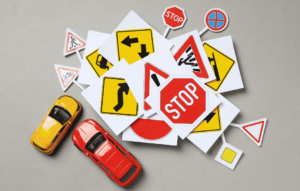
Driving can be seen as the initial step or necessity towards independence and freedom. However, before you hit the road, you must first complete the necessary driver’s education. In Edmonton, Alberta driving courses are divided into different classes, each designed for different types of vehicles. Let us explain what you will learn in Class 1, 2, 3, 4, and 6 courses in a simple and easy-to-understand way, so you know exactly what to expect!
Types of Driving Courses
1. Class 1 Driving Course: Commercial Vehicles
The class 1 driving course is for people who want to drive large commercial vehicles, like big or semi-trucks. If you want to work in logistics or dream of driving trucks, you should go for this one. Here’s what you’ll get to learn:
- Driving Large Trucks: You’ll practice driving vehicles that are much larger than regular cars. This includes learning how to handle their size, move through tight spaces, and keep a safe distance from other vehicles.
- Safety and Inspection: Before driving, it is important to know about the vehicle for safety purposes. In this course, you’ll also learn how to inspect the truck, like checking the tire, brakes, lights, and engine to avoid any future mishappenings.
- Handling Long-Distance Travel: Many learners who opt for class 1 licenses are someone who works or wants to work in transportation. Meaning they may have to travel long distances, to make you fit for it you’ll learn how to manage driving for hours at a time, including rest stops, staying alert, and handling the challenges of long road trips.
- Cargo Handling: This also includes how to load and secure cargo to make sure nothing falls off or gets damaged during transport.

2. Class 2 Driving Course: Buses and Large Vehicles
The Class 2 driving course is designed for people who want to drive buses, coaches, or other large vehicles used for public transportation, remember it is different from trucks. This could include driving a city bus, a school bus, or even a tour bus. Here’s what’s included:
- Driving a Large Vehicle: Similar to Class 1, you’ll get to practice driving larger vehicles. However, as mentioned earlier these vehicles are built for carrying many passengers meaning the safety of the people is the priority, so the main focus in this is to stop and start the vehicle smoothly to ensure their comfort.
- Passenger Safety: In this course, you’ll also have to learn the rules and safety procedures to follow when driving passengers. This includes everything from loading and unloading passengers safely to understanding emergency protocols.
- Navigating Narrow Spaces: As buses and coaches are big, you’ll practice how to drive in crowded or tight spaces. This is important as it requires a lot of skill and concentration to avoid hitting other vehicles, curbs, or pedestrians.
- Understanding Public Transit Rules: For driving a public bus, you’ll need to learn about the rules specific to public transit, including traffic laws and procedures for dealing with passengers and stops. All these are included in the course for you.
3. Class 3 Driving Course: Heavy Trucks (But Smaller than Class 1)
It can be confusing for some as this class also includes driving trucks, but the class 3 course is for people who want to drive large trucks that are not as big as the one in class 1. These are often used for delivery or transporting goods. For example, delivery trucks, garbage trucks, or fire trucks. Here are the things included in it:
- Driving Heavy Trucks: You’ll get behind the wheel of trucks that are smaller compared to the big trucks, but still much bigger than your regular car. This includes learning how to handle their weight and mobility.
- Cargo Transport: Just like in Class 1, you’ll learn how to safely transport goods. focusing on how to load and unload while making sure that your cargo is properly secured and it doesn’t shift or cause accidents.
- City Driving: As in this vehicle like delivery or dump trucks are included, meaning the driver has to move in cities and crowded or tight space, so you’ll learn how to navigate busy streets and traffic, while also ensuring your truck is safe and functional at all times.
- Basic Truck Maintenance: You’ll learn how to take care of these trucks like checking for mechanical issues, and knowing what to do if something goes wrong while you’re on the road.
4. Class 4 Course: Small Commercial Vehicles
If you are someone who wants to drive smaller commercial vehicles, like taxis, delivery vans, etc., this course is for you. This is perfect if you drive a car for work, like a delivery service or ride-sharing company. Here’s what is included:
- Driving Small Commercial Vehicles: In this you’ll practice driving smaller trucks, vans, and taxis. This is more like driving a regular car, but with some extra responsibilities since you’re driving for work.
- Customer Service: When we talk about taxis it is likely that many people will ride in or interact with you and your vehicle, for this reason, you’ll learn the basics of customer service whether you’re driving passengers in a taxi or delivering packages to customers.
- Route Planning: You’ll also learn how to plan efficient routes, ensuring you get to your destination quickly and safely, without wasting fuel or time.
- Vehicle Care: Like all the courses you’ll get tips on how to maintain the vehicle you’re driving to make sure it stays in good shape, so you’re always ready for work.
5. Class 6 Course: Standard Cars and Motorcycles
Finally, this is the most common driving course as is it for people who want to drive regular cars. This includes everyday vehicles. It includes:
- Driving a Car: If you’re just starting out, you’ll learn the basics of driving. This includes steering, braking, turning, and following road signs. You’ll also get practice driving in different conditions, such as on highways, in the city, or in bad weather.
- Road Safety and Traffic Laws: As the word suggests you’ll learn about the rules of the road. This includes knowing when to stop, how to signal, and how to avoid accidents by being aware of other drivers.
- Parking and Reversing: In driving the most important and difficult skill is learning how to park. You’ll practice parallel parking, reversing into spaces, and parking in tight spots.
As you get to know from this article, each driving class has a specific set of skills tailored to different types of vehicles. The knowledge you gain from these courses will prepare you to drive safely and responsibly. If you want to learn driving and become a skilled driver it is important to find a good driving school that offers the courses to your need, from basic to more specialized vehicle training.
A Max Driving School in Alberta Edmonton offers a variety of courses to choose from. You can select the one that fits your goals, and if you are unsure which course is best for you, don’t hesitate to contact us at 780-243-7555. Or visit our site and learn more about our courses and services. We ensure you get the best training for the type of vehicle you want to drive.
Remember, whether you’re behind the wheel of a giant truck, school bus, or a car, driving is a serious responsibility. With the right training, you’ll not only earn your license but also gain the expertise needed for a successful driving career.







